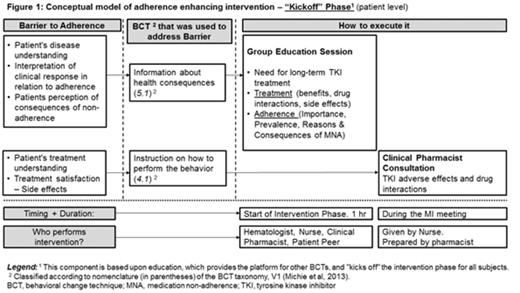Abstract
Introduction: Medication non-adherence (MNA) to tyrosine kinase inhibitors TKIs occurs in around 30% of chronic myeloid leukemia (CML) patients and is associated with adverse outcomes (Noens, 2009; Marin, 2010). Data on adherence-enhancing interventions (AEIs) in CML are scarce and an improvement in dose implementation has yet to be shown.
Objective: To evaluate the efficacy of a multilevel AEI in improving MNA to TKIs in CML.
Methods: We initiated a prospective multicenter (N=4) pre-post adherence intervention pilot study in CML (NCT01768689). Patients were eligible if they had received at least 3 months of imatinib, nilotinib or dasatinib for CML, irrespective of treatment line or subsequent duration. TKI adherence was assessed for 7.5 months using electronic monitoring (EM) with MEMS (Medical Events Monitoring System 6) and BAASIS. The MEMS bottle cap contains a micro-electronic circuit that registers dates and times of cap opening. The BAASIS is a 4-item patient reported outcome used to assess adherence in solid organ transplants and CML (Cleemput, 2007; Noens, 2009).
We designed an investigational AEI to address known barriers to TKI adherence in CML (Figures 1 & 2), using components with proven efficacy in improving MNA in chronic diseases. The key elements were: behavioral change techniques (BCT); motivational interviewing (MI; Figure 2); and multilevel including patient (Figure 1), peer group and health care provider levels (not shown). The BCT taxonomy developed by Michie et al (Ann Behav Med, 2013) was used in Figures 1 & 2 to describe the intervention and to facilitate its reproducibility.
During the first 4.5 months of adherence monitoring, MNA was managed as per local practice. The intervention phase was then initiated (Figure 1) and adherence measured for a further 3 months. The pre and post-intervention periods were defined as the 3 months before and after the initiation of the AEI, respectively. The primary outcome measure was EM adherence using MEMS, and primary analysis was the comparison between pre and post-intervention adherence, expressed as the percentage of days with drug taken as prescribed. Generalized Estimating Equation model was used to adjust for correlation between adherence levels pre and post intervention, measured in the same patient. We also explored the association between adherence according to BAASIS (at 3 different time-points during the pre/post intervention periods) and the corresponding 1-month periods of EM adherence.
Results: Between 10/2013 and 7/2014, we enrolled 55 CML patients (median age, 60.5 years; median current TKI duration, 34 months) receiving imatinib (59%), nilotinib (18%) or dasatinib (23%).
Median pre-intervention EM adherence was 97.5% (min 48%; 10th percentile: 82.6%; 25th: 92.1%; 75th: 99.3%; 90th: 100%; max 100%) and the mean was 93%. Non-membership in a CML patients group (51%), living alone (18%) and 3rd line treatment (9%) were each risk factors for pre-intervention MNA on multivariate analysis, whereby mean adherence was 7% (p<0.01), 10.2% (p=0.03) and 13.9% (p=0.01) lower than patients without each of these risk factors, respectively. The estimated mean adherence was near perfect (99.7%) with none of the above risk factors (N=21; 38%).
The AEI affected a 1.45% improvement in adherence for the whole cohort (95% CI: 0.09-2.8%, p=0.04). The AEI led to an improvement of 2.51% in the non-members of a CML patient group (95% CI: 0.2-4.8%, p=0.03) relative to 0.25% (p=0.71) in the members. By extrapolation, this corresponds to an additional 5.3 days of correct intakes over 1 year for the whole cohort, and 9.5 days for non-members of a CML patient group. Using an exploratory cut-off of EM adherence ≥ 95% as adherent, the BAASIS (N=132) correctly classified 75.5% (74/98) as adherent and 73% (25/34) as non-adherent.
Conclusion: The effect of the AEI is modest but statistically significant, and higher in non-members of a CML patients group. At the same time, this study shows the futility and potential resource wasting of trying to improve adherence in the large group of near-perfect adherers without risk factors. Our pilot study provides proof of concept that EM adherence may be improved in CML patients by a multilevel AEI, and that the magnitude of improvement is higher in subgroups at risk. These subgroups should be identified, if possible, by combining patient characteristics with the BAASIS.
Leader:Novartis: Research Funding. Sharf:Pfizer: Honoraria; BMS: Honoraria, Research Funding; Gilead: Honoraria; Novartis: Honoraria, Research Funding; Ariad: Honoraria, Research Funding. Tousset:MWV Healthcare: Employment. Ellis:Novartis: Other: Advisory Board; Pfizer: Other: Advisory Board. Raanani:BMS: Other: Advisory Board; Pfizer: Other: Advisory Board; Novartis: Other: Advisory Board, Research Funding; Ariad: Other: Advisory Board.
Author notes
Asterisk with author names denotes non-ASH members.



This feature is available to Subscribers Only
Sign In or Create an Account Close Modal